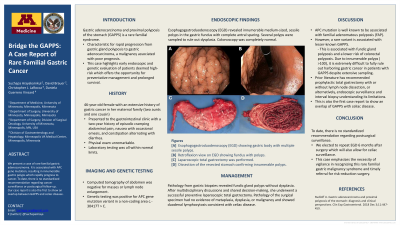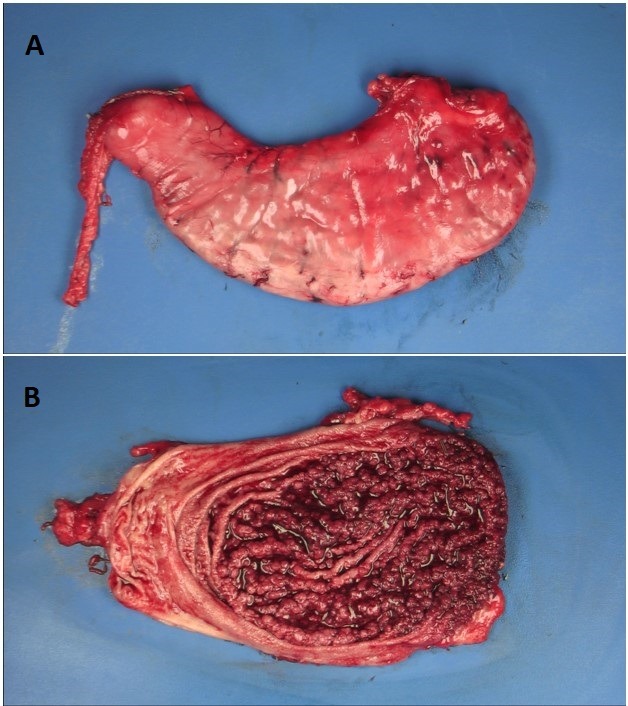Sunday Poster Session
Category: Stomach
P1636 - Bridge the GAPPS: A Case Report of Rare Familial Gastric Cancer
Sunday, October 27, 2024
3:30 PM - 7:00 PM ET
Location: Exhibit Hall E

Has Audio

Suchapa Arayakarnkul, MD
University of Minnesota
Minneapolis, MN
Presenting Author(s)
Award: Presidential Poster Award
Suchapa Arayakarnkul, MD1, David Brauer, MD, MPHS2, Christopher J. LaRocca, MD1, Daniela Guerrero Vinsard, MD3
1University of Minnesota, Minneapolis, MN; 2University of Minnesota Medical School, Minneapolis, MN; 3Minneapolis VA Health Care System, Minneapolis, MN
Introduction: Gastric adenocarcinoma and proximal polyposis of the stomach (GAPPS) is a rare familial syndrome characterized by rapid progression from gastric gland polyposis to gastric adenocarcinoma, a malignancy associated with poor prognosis. This case highlights early endoscopic and genetic evaluation of patients deemed high-risk which offers the opportunity for preventative management and prolonged survival.
Case Description/Methods: A 46-year-old female with an extensive history of gastric cancer in her maternal family (two aunts and one cousin), presented to the gastrointestinal clinic. She endorsed a two-year history of episodic cramping abdominal pain, nausea with occasional emesis, and constipation alternating with diarrhea. Esophagogastroduodenoscopy (EGD) revealed innumerable medium-sized, sessile polyps in the gastric fundus with complete antral sparing. Several polyps were sampled to rule out dysplasia. Colonoscopy was completely normal. Computed tomography of abdomen was negative for masses or lymph node enlargement. Genetic testing was positive for APC gene mutation variant in a non-coding area c.-30417T >C. Pathology from gastric biopsies revealed fundic gland polyps without dysplasia. After multidisciplinary discussions and shared decision-making, she underwent a successful preventive laparoscopic total gastrectomy. Pathology of the surgical specimen had no evidence of metaplasia, dysplasia or malignancy and showed duodenal lymphocytosis consistent with celiac disease.
Discussion: APC mutation is well known to be associated with familial adenomatous polyposis (FAP), however, a rare variant is associated with lesser-known GAPPS. This is associated with fundic gland polyposis and a lower risk of colorectal polyposis. Due to innumerable polyps ( >100), it is extremely difficult to fully rule out harboring gastric cancer in patients with GAPPS despite extensive sampling. Prior literature has recommended prophylactic total gastrectomy with or without lymph node dissection, or alternatively, endoscopic surveillance and interval biopsy understanding its limitations. This is also the first case report to show an overlap of GAPPS with celiac disease. To date, there is no standardized recommendation regarding postsurgical surveillance, and we elected to repeat EGD 6 months after surgery which will also allow for celiac surveillance. This case emphasizes the necessity of vigilance in recognition of this rare familial gastric malignancy syndrome and timely referral for risk-reduction surgery.

Disclosures:
Suchapa Arayakarnkul, MD1, David Brauer, MD, MPHS2, Christopher J. LaRocca, MD1, Daniela Guerrero Vinsard, MD3. P1636 - Bridge the GAPPS: A Case Report of Rare Familial Gastric Cancer, ACG 2024 Annual Scientific Meeting Abstracts. Philadelphia, PA: American College of Gastroenterology.
Suchapa Arayakarnkul, MD1, David Brauer, MD, MPHS2, Christopher J. LaRocca, MD1, Daniela Guerrero Vinsard, MD3
1University of Minnesota, Minneapolis, MN; 2University of Minnesota Medical School, Minneapolis, MN; 3Minneapolis VA Health Care System, Minneapolis, MN
Introduction: Gastric adenocarcinoma and proximal polyposis of the stomach (GAPPS) is a rare familial syndrome characterized by rapid progression from gastric gland polyposis to gastric adenocarcinoma, a malignancy associated with poor prognosis. This case highlights early endoscopic and genetic evaluation of patients deemed high-risk which offers the opportunity for preventative management and prolonged survival.
Case Description/Methods: A 46-year-old female with an extensive history of gastric cancer in her maternal family (two aunts and one cousin), presented to the gastrointestinal clinic. She endorsed a two-year history of episodic cramping abdominal pain, nausea with occasional emesis, and constipation alternating with diarrhea. Esophagogastroduodenoscopy (EGD) revealed innumerable medium-sized, sessile polyps in the gastric fundus with complete antral sparing. Several polyps were sampled to rule out dysplasia. Colonoscopy was completely normal. Computed tomography of abdomen was negative for masses or lymph node enlargement. Genetic testing was positive for APC gene mutation variant in a non-coding area c.-30417T >C. Pathology from gastric biopsies revealed fundic gland polyps without dysplasia. After multidisciplinary discussions and shared decision-making, she underwent a successful preventive laparoscopic total gastrectomy. Pathology of the surgical specimen had no evidence of metaplasia, dysplasia or malignancy and showed duodenal lymphocytosis consistent with celiac disease.
Discussion: APC mutation is well known to be associated with familial adenomatous polyposis (FAP), however, a rare variant is associated with lesser-known GAPPS. This is associated with fundic gland polyposis and a lower risk of colorectal polyposis. Due to innumerable polyps ( >100), it is extremely difficult to fully rule out harboring gastric cancer in patients with GAPPS despite extensive sampling. Prior literature has recommended prophylactic total gastrectomy with or without lymph node dissection, or alternatively, endoscopic surveillance and interval biopsy understanding its limitations. This is also the first case report to show an overlap of GAPPS with celiac disease. To date, there is no standardized recommendation regarding postsurgical surveillance, and we elected to repeat EGD 6 months after surgery which will also allow for celiac surveillance. This case emphasizes the necessity of vigilance in recognition of this rare familial gastric malignancy syndrome and timely referral for risk-reduction surgery.

Figure: A. Gross finding of surgical specimen following total gastrectomy
B. Dissection of stomach revealing innumerable polyps
B. Dissection of stomach revealing innumerable polyps
Disclosures:
Suchapa Arayakarnkul indicated no relevant financial relationships.
David Brauer indicated no relevant financial relationships.
Christopher LaRocca indicated no relevant financial relationships.
Daniela Guerrero Vinsard indicated no relevant financial relationships.
Suchapa Arayakarnkul, MD1, David Brauer, MD, MPHS2, Christopher J. LaRocca, MD1, Daniela Guerrero Vinsard, MD3. P1636 - Bridge the GAPPS: A Case Report of Rare Familial Gastric Cancer, ACG 2024 Annual Scientific Meeting Abstracts. Philadelphia, PA: American College of Gastroenterology.

